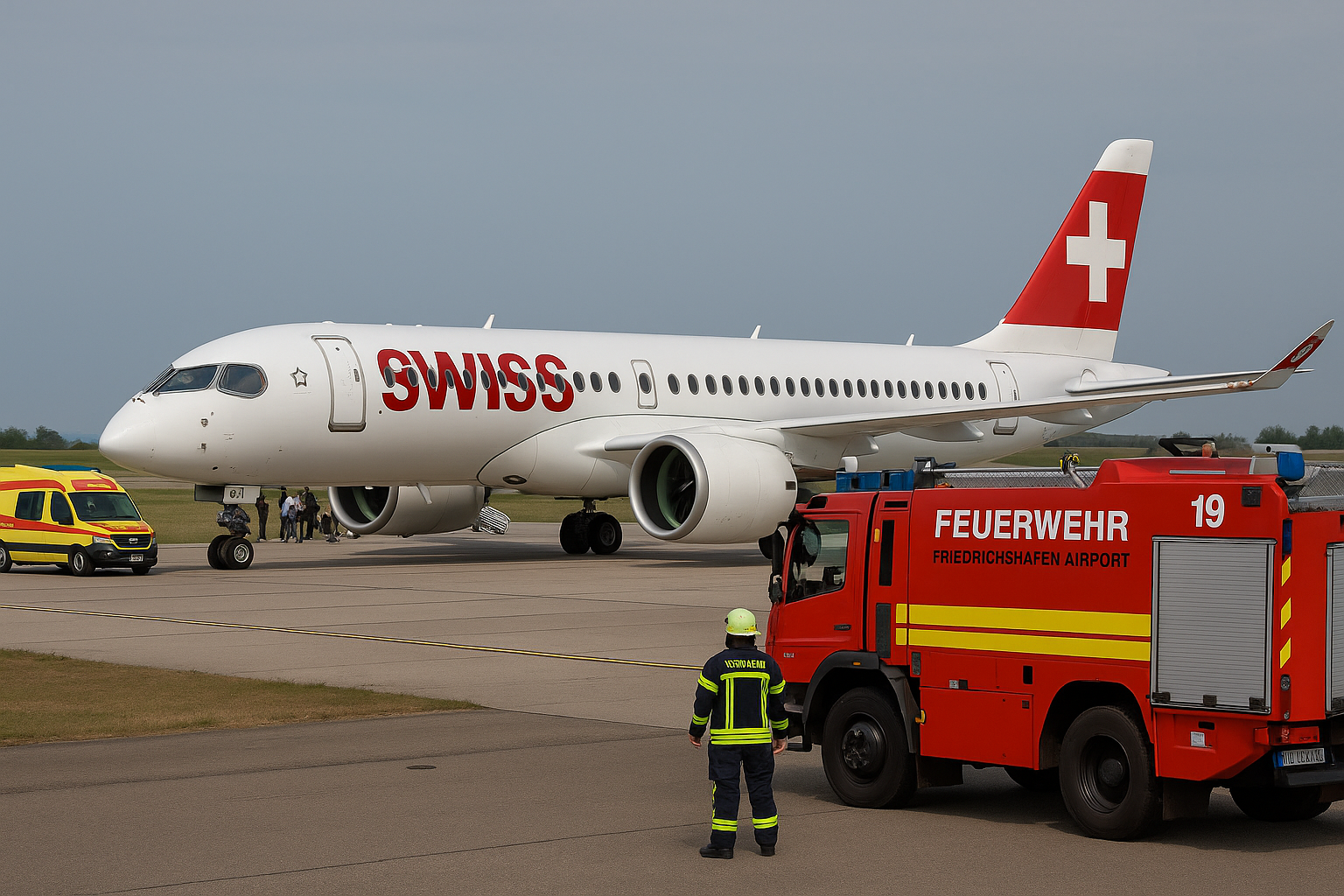A Swiss International Air Lines Airbus A220-300 was forced to make an emergency landing at Friedrichshafen Airport (FDH) in southern Germany on the morning of July 7, 2025, after smoke was detected in the cabin mid-flight. Flight LX123, operating between Belgrade Nikola Tesla Airport (BEG) and Zurich Airport (ZRH), safely landed without injury to its 115 passengers and four crew members.
According to official airline sources and the German aviation authority (Luftfahrt-Bundesamt), the crew initiated a diversion after cockpit instruments displayed multiple warning alerts, coinciding with reports of light smoke from the aircraft’s rear section. The incident occurred approximately 40 minutes into the flight, prompting the flight deck to declare a precautionary emergency and request an immediate landing at the nearest suitable airport—Friedrichshafen, located near Lake Constance in Baden-Württemberg.
Upon landing at around 11:00 AM local time, the aircraft was swiftly met by local emergency services, including fire brigades, police, and airport medical teams. Though no fire was ultimately found, authorities confirmed that standard aviation emergency procedures were followed to the letter. All passengers were safely evacuated using stairs, as the smoke was light and contained, eliminating the need for emergency slides.
Swiss International Air Lines promptly dispatched a technical inspection team to Friedrichshafen to investigate the source of the warning messages and smoke. Preliminary assessments have not yet determined the root cause, but the aircraft remains grounded pending a full evaluation in coordination with Swiss and German aviation safety authorities.
In a statement issued by the airline, officials praised the flight crew’s calm and professional handling of the situation. “Our pilots acted swiftly in accordance with established safety protocols. Passenger safety is our top priority, and we commend the quick response of both our crew and the local emergency services at Friedrichshafen Airport,” the spokesperson said.
Passengers were transferred from Friedrichshafen to Zurich via bus shortly after the emergency landing. Swiss International Air Lines confirmed that all affected passengers were accommodated with alternate travel arrangements to ensure minimal disruption to their journeys.
One of the passengers, Stefan Müller from Zurich, recounted the experience: “We noticed a slight burning smell, and soon after, the captain informed us that we were diverting. It was nerve-wracking, but everything was handled very professionally. We’re grateful to be safe.”
This is not the first time an A220 aircraft has experienced cabin-related technical issues. Aviation analysts point to similar incidents across the globe involving smoke warnings, typically resulting from electrical or air conditioning system faults. The A220, originally developed by Bombardier and now fully managed by Airbus, has otherwise maintained a strong safety record.
The Swiss Federal Office of Civil Aviation (FOCA) is assisting in the investigation, alongside German aviation safety regulators. While no foul play or mechanical failure has yet been officially identified, safety experts emphasize that such precautionary landings are vital for mitigating potential risk to life.
This latest incident echoes a similar event earlier this year involving a Delta Air Lines Airbus A350 that returned to Los Angeles after smoke was reported onboard during a transpacific flight to Sydney. In both cases, decisive pilot actions and ground coordination ensured safe outcomes, reinforcing the strength of modern aviation safety systems.
Friedrichshafen Airport, though relatively small, is fully equipped for handling emergency situations. A spokesperson for the airport noted, “We train regularly for such scenarios. Thanks to coordination with the airline and air traffic control, everything went smoothly.”
The Swiss A220 will undergo a comprehensive mechanical and safety inspection before being cleared to fly again. Meanwhile, the airline has reassured future passengers that all its A220 aircraft continue to meet stringent safety and maintenance standards.
For now, travelers departing from Zurich and Belgrade can expect normal operations, as Swiss has not issued any broader fleet alerts. The airline encourages any concerned passengers to reach out to customer service for travel updates or assistance.
Conclusion
The safe handling of Swiss flight LX123’s in-flight emergency demonstrates the high standards and training of European aviation personnel. As investigations proceed, both the airline and regulators aim to use the incident as a learning opportunity to enhance aircraft safety systems and emergency readiness.
While unsettling, this event ended safely—thanks to the fast, coordinated response of the crew and Friedrichshafen’s emergency teams. It serves as a potent reminder of the crucial role that rigorous safety protocols play in modern air travel.
For more travel news like this, keep reading Global Travel Wire












